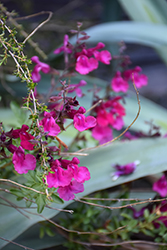It's all about ...
plants

Height: 3 feet
Spread: 3 feet
Sunlight:
![]()
Hardiness Zone: 8b
Other Names: Salvia muelleri x microphylla
Description:
A delightful small shrub with heavy flower displays of violet-red blooms in spring and fall; great for dry, sunny areas; a perfect addition to borders or beds with its broad, dark green foliage and dense, bushy form; little water required once established
Ornamental Features
Dark Dancer Sage has masses of beautiful spikes of lightly-scented violet tubular flowers with red overtones rising above the foliage from mid spring to mid fall, which are most effective when planted in groupings. The flowers are excellent for cutting. Its attractive fragrant oval leaves remain dark green in colour throughout the year.
Landscape Attributes
Dark Dancer Sage is a multi-stemmed evergreen perennial with an upright spreading habit of growth. Its medium texture blends into the garden, but can always be balanced by a couple of finer or coarser plants for an effective composition.
This is a relatively low maintenance plant, and should only be pruned after flowering to avoid removing any of the current season's flowers. It is a good choice for attracting bees, butterflies and hummingbirds to your yard, but is not particularly attractive to deer who tend to leave it alone in favor of tastier treats. It has no significant negative characteristics.
Dark Dancer Sage is recommended for the following landscape applications;
- Mass Planting
- Hedges/Screening
- General Garden Use
Planting & Growing
Dark Dancer Sage will grow to be about 30 inches tall at maturity, with a spread of 3 feet. Although it is technically a woody plant, this plant can be expected to behave as a perennial in our climate if planted outdoors over the winter, usually regrowing from its base (crown) the following year. As such, gardeners should take into consideration that it will perform differently than it would in its native habitat.
This plant should only be grown in full sunlight. It prefers dry to average moisture levels with very well-drained soil, and will often die in standing water. It is considered to be drought-tolerant, and thus makes an ideal choice for a low-water garden or xeriscape application. To help this plant achive its best flowering performance, periodically apply a flower-boosting fertilizer from early spring through into the active growing season. It is not particular as to soil type or pH. It is somewhat tolerant of urban pollution. This particular variety is an interspecific hybrid. It can be propagated by cuttings; however, as a cultivated variety, be aware that it may be subject to certain restrictions or prohibitions on propagation.
This plant is not reliably hardy in our region, and certain restrictions may apply; contact the store for more information.
